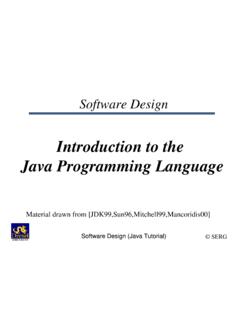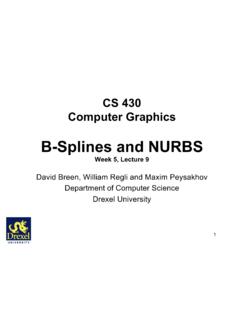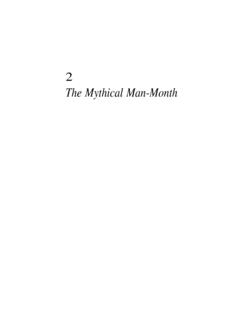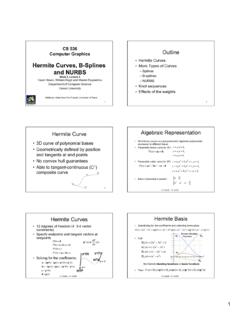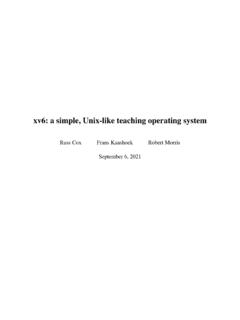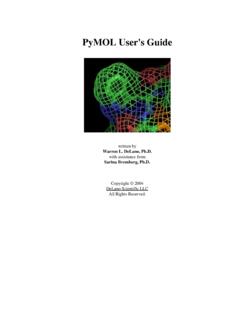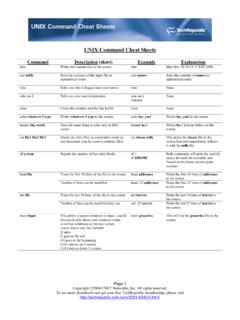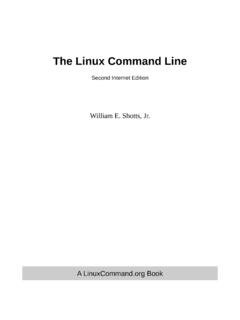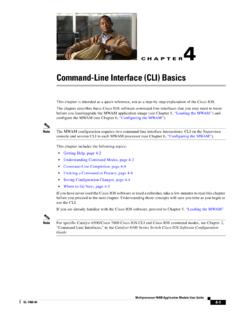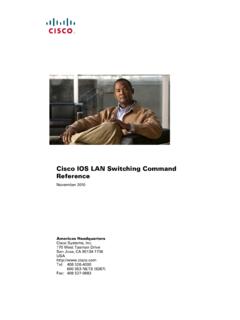Transcription of The Unix Operating System - Drexel CCI
1 The unix Operating SystemSE 101 Spiros MancoridisWhat is an OS?An Operating System (OS) is software that manages the resources of a computerLike most managers, the OS aims to manage its resources in a safe and efficient wayExamples of computer resources are: CPU, RAM, disk memory, printers, displays, keyboard, mouse, etcThe OS also isolates users and application programmers from the underlying computer Operating SystemsMicrosoft WindowsUnixOS ArchitectureWithout an OS, every application would have to implement some part of this software hierarchy ..UnixA popular multi-user, multi-tasking OSAttributes: stability, portability, securityCreated at Bell Labs by Dennis Ritchie and Ken Thompson (won the ACM Turing Award in 1983) unix is considered one of the greatest achievements in computer scienceHas been around since the 1960s in various forms, , AIX, SCO unix , SunOS, FreeBSD, OpenBSD, NetBSD, Linux, Mac OS XUnixMultiuser and MultitaskingToolbox philosophy Concise syntaxDesigned by programmers for programmers1983 ACM Turning Award ( unix )ACM is the Association for Computing MachineryWorld s largest educational and scientific computer societyYou can become a student member too ACM awards the Turing Award every year.
2 It is the Nobel Prize of computingNamed after british mathematician Alan M. Turing (1912-1954)Thompson and RitchieAlan M. TuringUnix KernelIncludes device drivers for computer hardware devices, , graphics cards, network cards, disksA device driver is a program that allows computer programs to interact with hardware devicesCPU and memory management File System managementImplements System calls that can be used by application programs and System utilitiesWhat s inside the Box?The von Neumann ArchitectureThe OS hides this complexity from the programmerUnix Shells and GUIS Shells are used for command line input/output to and from , sh (Bourne shell), bash (Bourne again shell), csh (C shell), ksh(Korn shell)GUIs are used for graphical , Linux KDE, GNOME, Mac OS LeopardUnix System UtilitiesSystem utilities are specialized software tools (commands) ,ls, cp, grep, awk, bc, wc, more, rm, mkdir, ..Daemons provide remote network and administration services , ssh (remote login)lpd (remote printing)httpd (serves web pages) unix Application ProgramsThis is the software that users commonly interact with , vi and emacs (text editors)gcc (GNU C compiler)javac (Java compiler)java (Java run time virtual machine System )What is a programming language?
3 A programming language is an artificial language designed to express computations that will be executed on a computerProgramming languages have a syntax (form) and semantics (meaning)Java and C are example programming languagesWhat is a compiler?A compiler is a computer program that transforms human readable source code of another computer program into machine readable code that a computer can execute. The act of transforming source code into machine code is called ;import ;import ;import ;public class Main { public static void main(String[] args) { String[] array = {"Programming", "is", "cool"}; List<String> list = (array); Iterator<String> iterator = (); while ( ()) { ( ()); } }}Java Source CodeJava Compilation ProcessWhat is a Virtual Machine?A virtual machine (VM) is a software implementation of a computer that executes programs like a physical computerA System VM implements a complete computer that can support the execution of a real OS ( , vmware, KVM)A process VM is designed to run a single program ( , Java VM) Improves program portability, , the ability to reuse software on a different platform with little or no modificationLogging into Unixlogin: <type your user id>password: <type your password>$ pwd/home/spiros$ exituserid is the unique name of the userpassword can be changedpassword should only be known by usersystem staff does not know user password, but they have the power to change itUnix is case sensitiveLogging into Unixpasswords.
4 Domake sure no one is looking while you enter your passwordchange your password oftenchoose a password that you can rememberuse at least 8 characters (letters) in your passwordMix letters (upper and lower case) with digits and punctuationPasswords .. Don tuse a word that can be found in a dictionaryuse a namekeep your password written on a piece of paperuse control charactersuse personal information ( , address, birthday, name of pet)ever give your password to anybodychanging passwordUse the unix passwd commandYou will be prompted for both your current password (once) and your new password (twice)change your initial password immediately Logging out of unixlogout leaves the systemexit quits the shell^D same as logout, but often disabledUnix Commands$ command -options targets man man (a manual on the unix manual)There should be a man page for every unix command , man lsRead the man pages, they are very useful and convenientSome unix commandspasswddatehostnamewholast fingerwclearcalbc -lhistorysshTry these unix commands and see what they do.
5 The man pages can give you details on how to use these (and other) commandsUnix FilesystemOrdinary FilesFiles contain data, program code, etcFile names cannot have the / character in themDirectoriesContain files and other directoriesLinksA link is a pointer reference to another file (like an alias)DevicesAllows applications to access hardware devicesUnix Filesystem HierArchyUnix DiRectories/ The "root" directory/bin Essential low-level System utilities/usr/bin Higher-level System utilities and application programs/sbin Superuser System utilities (for performing System administration tasks)/lib Program libraries (collections of System calls that can be included in programs by a compiler)for low-level System utilities/usr/lib Program libraries for higher-level user programs/tmp Temporary file storage space (can be used by any user)/home User home directories containing personal file space for each user.
6 Each directory is named after the login of the unix System configuration and information files/dev Hardware devices/proc A pseudo-filesystem which is used as an interface to the kernel. Includes a sub- directory for each active program (or process).Useful UnixFilesystem commands$ cd /usr/bin$ pwd/usr/bin$ cd /$ lsbin/ lib/ media/ proc/ selinux/ sys/ var/ boot/!dev/ homes/ lib32/ mnt/ root/ site/ tmp/ etc/ opt/ sbin/ srv/ usr/$ man lsls -l An example of the output is of ls -l is:drwxr-xr-x 3 spiros serg 238 May 5 2:05 type is a single character which is either 'd' (directory), '-' (ordinary file), 'l' (symbolic link). permissions is a set of characters describing access rights. There are 9 permission characters, describing 3 access types given to 3 user categories. The three access types are read ('r'), write ('w') and execute ('x'), and the three users categories are the user who owns the file, users in the group that the file belongs to and other users (the general public).
7 An 'r', 'w' or 'x' character means the corresponding permission is present; a '-' means it is absent. links refers to the number of filesystem links pointing to the file or directory. owner is the user who created the file or directory. group denotes a collection of users who are allowed to access the file according to the group access rights specified in the permissions field. size is the length of a file, or the number of bytes used by the Operating System to store the list of files in a directory. date is the date when the file or directory was last modified. The -u option display the time when the file was last accessed (read). name is the name of the file or unix Filesystem commandscd path (change directory to path)mkdir directory (make a new directory)rmdir directory (remove a directory)cp source-file destination-file (copy source-file into destination-file)cp source-file(s) destination-directory (copy source files into destination-directory)useful unix filesystem commandsmv source destination (move/rename source file or directory to destination file or directory)rm file(s) (remove/delete files)
8 Rm -rf directory (remove entire directory)cat target-file(s) (concatenate target files and display them on the screen)cat target-file(s) > (store concatenation to output file)useful unix filesystem commandsln -s filename linkname (create a pointer to filename and call it linkname)cat ?piros (concatenates all files that start with any character and end with piros)cat * (concatenates all files in the current directory)ls [a-c]*[x-z] (lists files that start with a letter from a-c and end with a letter from x-z)File and DirectoryPermissionschmod options filesfor options u (user), g (group), o (other), a (all), r (read), w (write), x (execute), + (add permission), - (remove permission), = (assign permission)What does chmod ug=rw, o-rw, a-x *.
9 Txt do?How about chmod -R go+r dir ?How about chmod 600 ?chgrp group file(s) (changes the group permissions for the files, works with -R option) unix File Commands file filename(s) (reports on the type of a file , text, HTML, Java source code)head -num filename (displays the first num lines of a file)tail -num filename (displays the last num lines of a file)tail -f filename (continuously outputs the last few lines of a file being modified)the unix find commandfind directory -name targetfile -print (look for targetfile in any part of the directory rooted at directory), ,find /home -name *.java -printwhich command (gives path where the executable code of command resides), ,which ls (should return /bin/ls) unix grep commandgrep options pattern files (searches the files for lines that match a given pattern).
10 , grep Drexel *.txtgrep Drexel `find . -name *.txt -print`grep -i Drexel *.txtunix sort commandsort filename(s) (sorts line in a group of concatenated files alphabetically)sort -n filename(s) (sorts line in a group of concatenated files numerically)uniq filename (removes duplicate adjacent lines from a file)sort > file archivingtar -cvf archivename filenames (create archive from a list of files or directories)tar -tvm archivename (list contents of an archive)tar -xvf archivename (extract and restore archive)tar -cvf srctar -xvf file compressionzip directory/* (compresses contents of directory and store them in )

